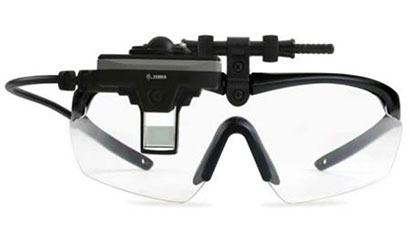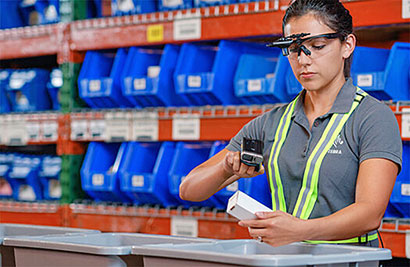|
Zebra HD4000
Innovative head-mounted display integrates with handhelds for a better human-machine interface
(by Conrad H. Blickenstorfer)
Share on:



On December 3, 2019, sort of hidden in a more general news release about warehouse productivity-boosting solutions, Zebra Technologies Corporation announced a very interesting device. The new enterprise-class HD4000 head-mounted display, connected to a handheld computer or scanner, attaches to safety glasses, providing an integrated heads-up screen that shows relevant contextual information relating to whatever it is a worker is doing.

The HD4000 is not a computer, it's a connected, intelligent display that works in conjunction with whichever of Zebra's vast array of handhelds someone is using. So why is that exciting? What's the relevance of it?
It's important because with the HD-4000 head-mount, Zebra addresses one of modern life's quintessential problems, that of mobile technology hogging too much of our attention. How often are we glued to our smartphones, whip them out to look up this and that? Our lives are in those devices and they've become the center of our attention.
This problem applies to work as well. Connected handheld devices have revolutionized warehouse and many other operations, significantly boosting productivity in the process. But handheld devices require constant interaction, constant lookups, constant tapping on the screen. With all the benefits they offer, handhelds can demand too much of our attention.
Optimizing the use of our senses
Zebra's idea with the HD4000 head-mounted display is to cut down the number of times a worker has to pick up the handheld computer to get information from its display, therefore leaving the hands free and the eyes on the job.
How can this improve the work flow? Here are a few examples:
- In a warehouse, the HD4000 can direct users to the right pick locations and verify their picks. No need to check with the handheld multiple times.
- On a shop floor, the HD4000 can show step-by-step instructions for assembly workers with real-time visual documentation. No need to pick up the handheld again and again.
- During an inspection, the HD4000 can prompt for all the necessary steps. No need to tap on the handheld computer or tablet screen, search for the next steps, launch the camera, locate the next document, etc.
- Repair technicians benefit from hands-free instructions on the HD4000 display, enabling quick and error-free task completion without ever having to pick up the handheld.
In each instance, the worker can concentrate on the task at hand rather than having to go back and forth to the handheld for lookups and direction. It's easy to see that the potential benefits of hands-free directed-action workflows are almost unlimited.
How does the HD4000 work?
If the HD4000 can do all that, one might ask, isn't it too heavy for comfort, between the electronics, battery and all? It's not, because the MD4000 does not replace the handheld. It works in conjunction with it, plugging into the handheld with a cable. This way, the MD4000 weighs just an ounce, mounted on a pair of standard off-the-shelf safety glasses. And it can be mounted on either side.
How does it work? First of all, since the HD4000 is not a computer it doesn't have a CPU or memory or any of that. It doesn't even have a battery because it gets whatever little power it uses (about 1 watt) from the host handheld that it's connected to.
In essence, the HD4000 adds a head tracker, a heads-up display, a camera, and a microphone to the handheld computer. It acts as an advanced, intelligent human-to-machine interface that has, given suitable software, the potential to greatly boost productivity.
How can the HD4000 interact with a handheld? Via dedicated or customized software. The HD4000 SDK has ready-to-use APIs and allows the development of custom apps that present required contextual information needed to perform the best next step in a process. The HD4000 can also function as a second screen via Android presentation mode. To simplify integration in the warehouse, Zebra provides warehouse templates for quick integration with leading Warehouse Management Systems (WMS).

Imagine the connected app on the handheld doing all the heavy lifting while issuing prompts on the HD4000 when needed, seeing via camera what the operator looks at, and listening to voice commands such as ok, next, back, repeat, stop, etc.
How does it hold up?
Ruggedness in the traditional sense doesn't really apply to the HD4000. It's a tiny thing that weighs barely more than an ounce. However, Zebra does claim IP67 sealing, which means the HD4000 can not only handle rain and such, but it'll survive falling and getting submerged in water. It also has an operating temperature range that likely exceeds that of the worker wearing it. It can handle 5-foot drops (which might be not quite enough if worn by a tall worker).
Overall, traditional ruggedness specs only tell part of the story. The real danger to a device like this little head-mount is getting crushed, having things broken off, or having the cable ripped out. We're fairly sure Zebra (and Six15 Technologies with which Zebra developed the HD4000) considered all that.
A promising addition to the Zebra lineup
As far as we're concerned, the HD4000 is another example of Zebra's never-ending quest to explore new ways towards better work flows and greater productivity. Ways that allow working smarter and not simply harder. For it's working smarter, and not harder, that gets the job done with a feeling of accomplishment and satisfaction.
Zebra loves to talk about and highlight their "Mobility DNA." DNA is something that is passed on through generations, and in this case the term certainly applies. It's this quest for new ideas, new solutions, and novel, better ways to get things done that was there at the old Symbol Technologies, then at the enterprise division of Motorola Solutions, and now at Zebra. -- C. H. Blickenstorfer, 12/2019
|



